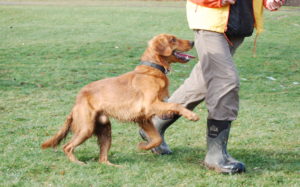I get asked a lot of interesting questions. In most situations, there’s not an easy or simple answer to the questions – instead, I have to ask more questions to find out what the family is really wanting to know.
How long will it take to train my dog?
My answer: Train him to do what?

Heeling training
Depending on the dog, his previous learning history and what is easier/harder for him – we might be able to do something in a few minutes or it might be a long term project. Occasionally something is an unrealistic goal based off of the resources (time, energy, money) someone may have.
During a trick workshop, one family asked about having their havanese jump up into their arms on cue. We started with the family sitting on the floor, then a chair, then their back against the wall, and in 5 minutes – she was doing it!
I have other families who may want a very nervous dog to love going to the dog park. After months of work, we might get the dog to love going to a regular park for sniff walks and time together or even walking with another dog. But just like not all people love going to big parties, not all dogs may find a dog park situation enjoyable.
Some tasks like training a retrieve will be easier for a dog who naturally plays fetch and gets into trouble by picking up everything in the house. For other dogs, this is a much more tricky project.
My answer: When is a person considered “educated?”
There are different milestones in human learning – finishing elementary school, finishing high school, undergraduate, etc. But even when someone is not actively involved in “formal” education, many people seek out opportunities to learn new things like skills or hobbies or just how a product is produced.
Dogs are always learning and often dogs really appreciate the interaction with people, the new activities, and the opportunities to problem solve. There’s no set age or skill set that makes a person be considered “educated” and the same goes for dogs. Not all dogs need to learn sit and down (or even one of those). I meet a lot of dogs where that’s not comfortable – and we might do a stand stay instead. But there are also thousands of dogs in my city that never go “to training” because they fit in so well to their household without it – and that’s ok too.
My answer: To what level of reliability?

Ok – maybe we train a dog to “stay” while the owner walks two steps away and returns. But how useful is that? Should we train him to stay while we open the door? While we unpack groceries? Can she stay while the kids have a picnic on the floor? What about if you tie your shoe? While a squirrel/cat/kid/fun thing runs by?
In most situations we can always up the distraction level – and there’s a point where it’s fun but maybe not as practical to continue with this.
Most dogs I meet already know how to “Sit” according to the owner – but they’ll primarily only respond if the owner is standing and in a low distraction environment. What if the owner is sitting and asks the dog to sit? And if the dog is on an uneven surface? Now what if a puppy is trying to bite her tail? Can she sit if she’s standing in a puddle? What if she’s far away?